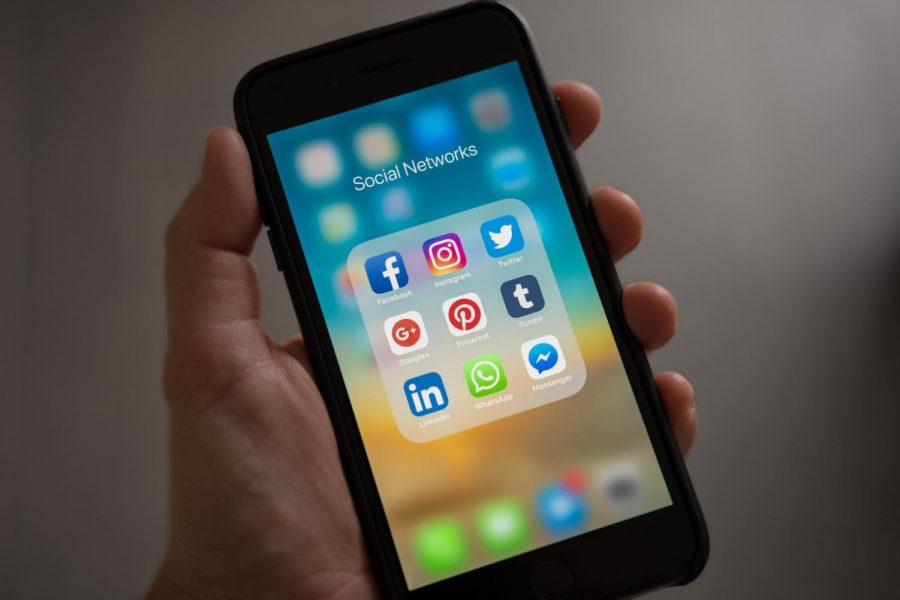Disinformation in the Digital Age
Chaos, Confusion, and Lack of Stability.
Disinformation has run rampant across all forms of social media, including Facebook.
February 5, 2021
Disinformation is the greatest threat to our nation’s stability. Looking at the origins of conspiracy theories and how they have spread, it always has lead back to manipulated information. It becomes far more sinister when a foreign adversary sees an opportunity to sway public opinion and takes it.
The 2016 presidential campaign season was intense, but one aspect of it that was overlooked, ignored, and quickly forgotten, was the large number of disinformation campaigns found everywhere, reaching people through social media platforms, especially Facebook.
Looking back, experts have agreed that they underestimated the power that disinformation during the digital age can have. An individual, group, or government could create some sort of campaign filled with fear tactics and false claims. That information could reach millions within minutes. It’s terrifyingly easy.
‘The Great Hack,’ a Netflix documentary about Cambridge Analytica’s role in collecting people’s data in enormous amounts, and how that data assisted them in electing certain candidates and leading certain campaigns, describes clearly a couple specific campaigns that were aimed at swaying people’s opinions. Not just any people, though. They are called “persuadables,’ people who may have voted sometimes, but don’t have strong stances and could be easily swayed through manipulation or through emotional triggers. Cambridge Analytica, using the Facebook platform, could decide who is a persuadable and who isn’t, through behavioral data by tracking user’s activity.
When targeting persuadables, there were a few deciding factors: how they voted, how strong their opinions were and how much they paid attention to current events were all considered. They also predicted how likely a group of Facebook users were to believing, or even becoming slightly interested in, conspiracy theories.
That belief may have been the ultimate decider of whether to classify a user as a “persuadable.”
Cambridge Analytica was only one entity that assisted in spreading false claims that would have an effect in the outcome of the presidential election. Numerous campaigns and individuals participated in this constant flow of false information leading up to the 2016 election.
Certain campaigns were targeted toward minority groups who their system guessed could be persuaded. The campaign essentially told them not to vote by pushing the narrative that not voting would be a symbol of protest against the so-called “corrupt system.”
U.S. officials have also found that Russia’s Internet Research Agency was involved with spreading similar disinformation during the 2016 campaign season, with goals to sway public opinion. Russia directly targeted minority groups with bogus campaigns filled with lies and baseless claims that were being thrown at the targets on a regular basis.
The IRA was indicted by the US in 2018 due to their efforts to manipulate election results.
According to the indictment, the IRA was tracking trends in the U.S. dating back to 2014. Two of the defendants mentioned also travelled to states such as Nevada, California, and New Mexico. Another defendant travelled to Atlanta. They claimed that they were traveling for personal reasons.
Another part of the indictment states that the IRA began create social media accounts, mostly on Twitter, claiming to be a legitimate person or organization. One account went by the handle, @TEN_GOP. This account appeared to be run by Tennessee’s Republican Party. In reality, it was being run straight from Russia by the IRA and reached about 100,000 followers. (These claims are mentioned on #36 in the report)
In the indictment, it is mentioned that the IRA, through their online social media operations, “tracked the size of the online U.S. audiences reached through posts, different types of engagement with the posts (such as likes, comments, and reposts), changes in audience size, and other metrics.” They also “received and maintained metrics reports on certain group pages and individualized posts.” (These claims are mentioned on #37 in the report)
The 2016 campaign season was a perfect example of what some would call a “disinformation op,” when looking at the way that false claims were so quickly spread on the dates leading up to the presidential election.
Very similarly, false claims were spread during the 2020 campaign season as well. This time, it came straight from political figures, including former President Donald Trump. The attempts of spreading disinformation were much less discreet, simply because it was easier to grasp voters, after years of continuous lies. Claims about how votes would be counted, lies about opponents, about how international relations would look like if one side wins and more. With these false claims hanging over voters’ heads, fear and hate were at a high point.
Another example of disinformation twisting facts during a crisis is the COVID-19 pandemic. Almost immediately, conspiracy theories began to spread from powerful people, to bots on social media. These conspiracy theories completely distorted the facts put out by officials and experts. Conspiracy theories all have one thing in common. They feed into people’s fears. Some may already be concerned about government interference. With that, those with bad intentions can use that concern to their own advantage and create distrust within communities and the nation.
Similar conspiracy theories were going around in African nations during the Ebola outbreak.
Although disinformation on digital platforms is more recent, similar tactics and strategies have been used for years – just in other forms.
After analyzing history and recent reports (or even after just keeping up with current events), we can determine that the attack on the Capitol in Washington, D.C., on Jan. 6 was also the result of years of disinformation.
Chaos, uncertainty, and lack of stability. That is what citizens of a nation experience when disinformation is flowing through easily accessed ports, such as social media.
Further Reading:
Russian Active Measures Campaigns and Interference in the 2016 U.S. Election
The Great Hack: The Film That Goes Behind the Scenes of the Facebook Data Scandal
The Great Hack Documentary | Netflix
Internet Research Agency Indictment (DOJ)
AP FACT CHECK: Trump’s vote falsehoods, into day of defeat
Trump’s lies about the election show how disinformation erodes democracy – The Conversation
Russian Efforts Against Election Infrastructure



KAY E MALAN • Feb 15, 2021 at 11:10 am
This was a well-written article and easy to read.
I would have liked if it had concluded with a suggestion of how we may protect ourselves from disinformation on social media. Unless the only option is to avoid using social media, like FB and Twitter, entirely?
Although I try to avoid FB for the reason’s outlined in the article, I also believe that social media has it’s place in sharing accurate information also.
Delnaz Kazemi • Feb 16, 2021 at 3:51 pm
Thank you for the feedback! That’s something that is important to look into. Almost everyone with a smartphone, including myself, scrolls through social media and sees loads of news and commentary throughout the day. In fact, one of the places that I enjoy political discussion the most is on Twitter. A few suggestions I would give are these: check your sources and make sure you are getting news from credible organizations. If the news or commentary is coming from an individual, check to see if they’re verified on any social media platform. If they are, take a look at their background and see where they get funding from and what country they are based in, and verify the info that they put out yourself. If they are a random, unverified, individual, verify anything they say yourself by checking with credible sources and refrain from sharing any post before you have verified it. Also, report any posts that include blatant lies and disinformation about current events, especially those who are targeting a specific group. Most of those posts are there to sway the opinion of the reader and they usually include fear tactics. Some may be bots as well. Commentary and opinions are different. But if someone is making false claims and stating that those claims are facts, a report on their post is needed. And lastly, and most importantly, stay vigilant, alert, and informed. Thanks for reading! – Delnaz Kazemi